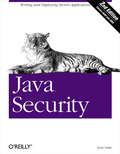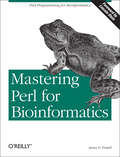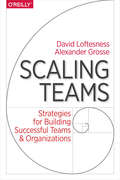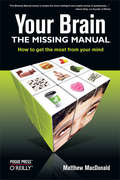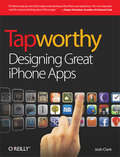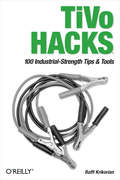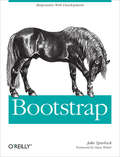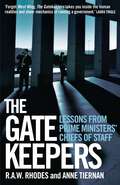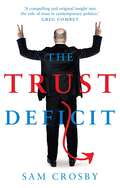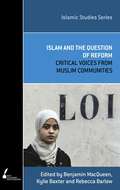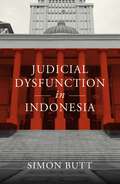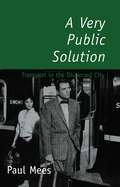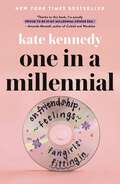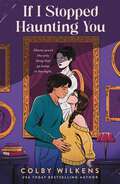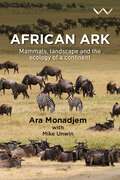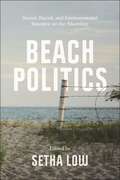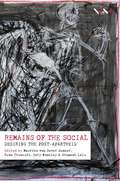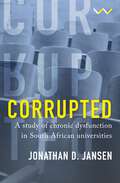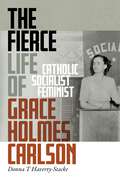- Table View
- List View
Java Security: Writing and Deploying Secure Applications
by Scott OaksOne of Java's most striking claims is that it provides a secure programming environment. Yet despite endless discussion, few people understand precisely what Java's claims mean and how it backs up those claims. If you're a developer, network administrator or anyone else who must understand or work with Java's security mechanisms, Java Security is the in-depth exploration you need.Java Security, 2nd Edition, focuses on the basic platform features of Java that provide security--the class loader, the bytecode verifier, and the security manager--and recent additions to Java that enhance this security model: digital signatures, security providers, and the access controller. The book covers the security model of Java 2, Version 1.3, which is significantly different from that of Java 1.1. It has extensive coverage of the two new important security APIs: JAAS (Java Authentication and Authorization Service) and JSSE (Java Secure Sockets Extension). Java Security, 2nd Edition, will give you a clear understanding of the architecture of Java's security model and how to use that model in both programming and administration.The book is intended primarily for programmers who want to write secure Java applications. However, it is also an excellent resource for system and network administrators who are interested in Java security, particularly those who are interested in assessing the risk of using Java and need to understand how the security model works in order to assess whether or not Java meets their security needs.
Mastering Perl for Bioinformatics: Perl Programming for Bioinformatics
by James TisdallHistorically, programming hasn't been considered a critical skill for biologists. But now, with access to vast amounts of biological data contained in public databases, programming skills are increasingly in strong demand in biology research and development. Perl, with its highly developed capacities in string handling, text processing, networking, and rapid prototyping, has emerged as the programming language of choice for biological data analysis.Mastering Perl for Bioinformatics covers the core Perl language and many of its module extensions, presenting them in the context of biological data and problems of pressing interest to the biological community. This book, along with Beginning Perl for Bioinformatics, forms a basic course in Perl programming. This second volume finishes the basic Perl tutorial material (references, complex data structures, object-oriented programming, use of modules--all presented in a biological context) and presents some advanced topics of considerable interest in bioinformatics.The range of topics covered in Mastering Perl for Bioinformatics prepares the reader for enduring and emerging developments in critical areas of bioinformatics programming such as:Gene findingString alignmentMethods of data storage and retrieval (SML and databases)Modeling of networks (graphs and Petri nets)Graphics (Tk)ParallelizationInterfacing with other programming languagesStatistics (PDL)Protein structure determinationBiological models of computation (DNA Computers)Biologists and computer scientists who have conquered the basics of Perl and are ready to move even further in their mastery of this versatile language will appreciate the author's well-balanced approach to applying Perl's analytical abilities to the field of bioinformatics. Full of practical examples and real-world biological problem solving, this book is a must for any reader wanting to move beyond beginner level Perl in bioinformatics.
Scaling Teams: Strategies for Building Successful Teams and Organizations
by Alexander Grosse David LoftesnessLeading a fast-growing team is a uniquely challenging experience. Startups with a hot product often double or triple in size quickly—a recipe for chaos if company leaders aren’t prepared for the pitfalls of hyper-growth. If you’re leading a startup or a new team between 10 and 150 people, this guide provides a practical approach to managing your way through these challenges.Each section covers essential strategies and tactics for managing growth, starting with a single team and exploring typical scaling points as the team grows in size and complexity. The book also provides many examples and lessons learned, based on the authors’ experience and interviews with industry leaders.Learn how to make the most of:Hiring: Learn a scalable hiring process for growing your teamPeople management: Use 1-on-1 mentorship, dispute resolution, and other techniques to ensure your team is happy and productiveOrganization: Motivate employees by applying five organizational design principlesCulture: Build a culture that can evolve as you grow, while remaining connected to the team’s core valuesCommunication: Ensure that important information—and only the important stuff—gets through
Your Brain: The Missing Manual (The\missing Manual Ser.)
by Matthew MacDonaldPuzzles and brain twisters to keep your mind sharp and your memory intact are all the rage today. More and more people -- Baby Boomers and information workers in particular -- are becoming concerned about their gray matter's ability to function, and with good reason. As this sensible and entertaining guide points out, your brain is easily your most important possession. It deserves proper upkeep.Your Brain: The Missing Manual is a practical look at how to get the most out of your brain -- not just how the brain works, but how you can use it more effectively. What makes this book different than the average self-help guide is that it's grounded in current neuroscience. You get a quick tour of several aspects of the brain, complete with useful advice about:Brain Food: The right fuel for the brain and how the brain commands hunger (including an explanation of the different chemicals that control appetite and cravings)Sleep: The sleep cycle and circadian rhythm, and how to get a good night's sleep (or do the best you can without it)Memory: Techniques for improving your recallReason: Learning to defeat common sense; logical fallacies (including tactics for winning arguments); and good reasons for bad prejudicesCreativity and Problem-Solving: Brainstorming tips and thinking not outside the box, but about the box -- in other words, find the assumptions that limit your ideas so you can break through themUnderstanding Other People's Brains: The battle of the sexes and babies developing brainsLearn about the built-in circuitry that makes office politics seem like a life-or-death struggle, causes you to toss important facts out of your memory if they're not emotionally charged, and encourages you to eat huge amounts of high-calorie snacks. With Your Brain: The Missing Manual you'll discover that, sometimes, you can learn to compensate for your brain or work around its limitations -- or at least to accept its eccentricities.Exploring your brain is the greatest adventure and biggest mystery you'll ever face. This guide has exactly the advice you need.
Padding, Borders, Outlines, and Margins in CSS: CSS Box Model Details
by Eric A. MeyerThe ability to apply margins, borders, and padding to any web page element is one of the things that sets CSS so far above traditional markup. With this practical guide, you will not only learn how to use these properties to lay out your document, but also how to change and control the appearance of any element on the page.Short and sweet, this short book is an excerpt from the upcoming fourth edition of CSS: The Definitive Guide. When you purchase either the print or the ebook edition of Padding, Borders, Outlines, and Margins in CSS, you’ll receive a discount on the entire Definitive Guide once it’s released. Why wait? Learn how to bring life to your web pages now.Understand the CSS box model, including the way different properties relate to one anotherUse tricks for defining padding values, including inline element paddingExplore border width, style, and color, plus the use of border imagesLearn how to use outlines: presentational elements that won’t affect layoutDive into the use of margins, including the way top and bottom margins collapse
Tapworthy: Designing Great iPhone Apps
by Josh ClarkSo you've got an idea for an iPhone app -- along with everyone else on the planet. Set your app apart with elegant design, efficient usability, and a healthy dose of personality. This accessible, well-written guide shows you how to design exceptional user experiences for the iPhone and iPod Touch through practical principles and a rich collection of visual examples.Whether you're a designer, programmer, manager, or marketer, Tapworthy teaches you to "think iPhone" and helps you ask the right questions -- and get the right answers -- throughout the design process. You'll explore how considerations of design, psychology, culture, ergonomics, and usability combine to create a tapworthy app. Along the way, you'll get behind-the-scenes insights from the designers of apps like Facebook, USA Today, Twitterrific, and many others.Develop your ideas from initial concept to finished designBuild an effortless user experience that rewards every tapExplore the secrets of designing for touchDiscover how and why people really use iPhone appsLearn to use iPhone controls the Apple wayCreate your own personality-packed visuals
TiVo Hacks: 100 Industrial-Strength Tips & Tools
by Raffi KrikorianTiVo Hacks helps you get the most out of your TiVo personal video recorder. Armed with just a screwdriver and basic understanding of PC hardware (or willingness to learn), preeminent hackability awaits. This book includes hacks for changing the order of recorded programs, activating the 30-second skip to blaze through commercials, upgrading TiVo's hard drive for more hours of recording, use of TiVo's Home Media Option to remotely schedule a recording via the Web, log in to the serial port for command-line access to programming data, log files, closed-captioning data, display graphics on the TiVo screen, and even play MP3s.Readers who use advanced hacks to put TiVo on their home network via the serial port, Ethernet, USB, or wireless (with 802.11b WiFi) will watch a whole new world open up. By installing various open source software packages, you can use TiVo for mail, instant messaging, caller-ID, and more. It's also easy to run a web server on TiVo to schedule recordings, access lists of recorded shows, and even display them on a web site. While TiVo gives viewers personalized control of their TVs, TiVo Hacks gives users personalized control of TiVo.Note: Not all TiVos are the same. The original TiVo, the Series 1, is the most hackable TiVo out there; it's a box thrown together with commodity parts and the TiVo code is running on open hardware. The Series 2 TiVo, the most commonly sold TiVo today, is not open. You won't see hacks in this book that involve modifying Series 2 software.
Bootstrap: Responsive Web Development
by Jake SpurlockDiscover how easy it is to design killer interfaces and responsive websites with the Bootstrap framework. This practical book gets you started building pages with Bootstrap’s HTML/CSS-based tools and design templates right away. You’ll also learn how to extend your app with interactive features, using its suite of jQuery plugins—often without writing a single line of code.Developed by Twitter and available free from GitHub, Bootstrap supports responsive design by dynamically adjusting your web page layout. With just a basic knowledge of HTML, CSS, and JavaScript, you can build apps that work equally well on desktop screens, smartphones, and tablets. This book shows you how.Become familiar with Bootstrap’s file structure, grid systems, and container layoutsLearn HTML elements for typography, code, tables, forms, buttons, images, and iconsDesign interfaces and other web elements, such as navigation, breadcrumbs, and custom modal windowsUse jQuery plugins for features such as revolving slideshows, tabbable interfaces, and dropdown menusModify everything from column count to typography colors with the LESS stylesheet language
Those We Forget: Recounting Australian Casualties of the First World War
by David NoonanThe official Australian casualty statistics suffered by the men of the Australian Imperial Force in the First World War are seriously wrong, with significant inaccuracies and omissions. Groundbreaking research exhaustively examining over 12,000 individual soldiers' records has revealed that hospitalisations for wounding, illness and injury suffered by men of the AIF are five times greater than officially acknowledged today. Why has it taken nearly one hundred years for this to come to light? Was it a conspiracy to suppress the toll, incompetence of Australia's official war historians Bean and Butler, or was it simply the unquestioning acceptance of the official record? You are invited on the journey in this book to find the truth. The findings are startling and will rewrite Australia's casualty statistics of the First World War. Lest we forget.
Young Menzies: Success, Failure, Resilience 1894–1942
by Zachary GormanSir Robert Menzies is a towering figure in Australian history. As the nation's longest-serving prime minister, he transformed and ultimately dominated the political landscape, implementing policies that laid the foundations of modern Australia. The story of Menzies and his governments is essential to the Australian narrative: the centrality of political liberalism, the defence of democracy through trying times, and the expanding horizons of our identity, prosperity and appreciation. The Young Menzies: Success, Failure, Resilience 1894-1942 explores the formative period of Menzies's life, when his personal outlook and system of beliefs that would help shape modern Australia were themselves still being formed. Contributors look at Menzies's ideas prior to their political practice and examine their context and origins. This period is also the time in which Menzies first attained power, though in difficult circumstances, when the focus of the nation was on survival. It was in losing office that Menzies was given the impetus to develop his vision for post-war Australia. This is the first of a four-volume history of Menzies and his world, based on conferences convened by the Robert Menzies Institute at the University of Melbourne. Contributors include Frank Bongiorno, Troy Bramston, Judith Brett, Nick Cater, Justice James Edelman, David Furse-Roberts, Anne Henderson, David Kemp, Angela Kittikhoun, Greg Melleuish and Scott Prasser, with a foreword by Geoffrey Blainey.
Gatekeepers: Lessons from prime ministers' chiefs of staff
by R.A.W. Rhodes Anne TiernanSo, you want to be Chief of Staff to the Australian Prime Minister? The Gatekeepers provides the key lessons to equip you for the job.Australian prime ministers need help and it is their chief of staff who supports the person and the office, steering the prime minister through the challenges and landmines of political leadership. It is about making sure the urgent doesn't crowd out the important. It comes down to finely tuned coordination. It is about winning support in cabinet, caucus and country.The Gatekeepers offers unparalleled insights into how things really work at the centre of Australia's governing networks from those who have worked as chiefs of staff under prime ministers from Fraser to Rudd. It identifies eight key lessons for success as the PM's gatekeeper and shock absorber.It reveals what to do, what not to do, how to do it and how not to do it.
Trust Deficit
by Sam CrosbyTrust is the most powerful weapon in the political arsenal. It can pierce an opponent's armour or deflect the most ferocious attack. It can explain difficult policies, and become a well of goodwill that politicians can draw from in their darkest hours. Yet despite its great value we are resigned to the idea that trust in politics will continue to decline.Drawing on contemporary political stories and examples, The Trust Deficit shows us how faith in our politicians has been eroded but how it can be rebuilt.Julia Gillard's pledge that there wouldn't be a carbon tax and Tony Abbott's promise of no cuts to health or education saw a collapse in their governments' levels of support.By breaking trust down to its elements—reliability and competence, openness and honesty—we see how recent leaders established trust and used it to their political advantage.
Party Thieves: The Real Story of the 2010 Election
by Barrie CassidyBarrie Cassidy picked a hell of an election to cover: changes of leaders on both sides of politics, Australia's first female Prime Minister, a hung parliament and a country not knowing who its Prime Minister was for nearly three weeks.But in the beginning were the Party Thieves, Malcolm Turnbull and Kevin Rudd. Turnbull's manic desire to get his own way in the party, and because he simply stopped listening, led to his demise. Rudd stole the party through his authoritarian approach to government and a cabinet that felt alienated from the job of governing.In both cases, the members of their respective parties came at the Party Thieves to reclaim what was rightfully theirs, and set the stage for the ascension of Tony Abbott and Julia Gillard.And all that before we even get to the 2010 election campaign.The Party Thieves is more than just a campaign diary of the extraordinary 2010 election and its aftermath; it is a rip-roaring, incisive analysis of a tumultuous nine months in politics that even surprised veteran journalists such as Cassidy. This is a must read for anyone interested in Australian politics of any persuasion.
Islam and the Question of Reform (Islamic Studies Series)
by Benjamin MacQueen Kylie Baxter Rebecca BarlowReform, by definition, is not a complete break with tradition, but a determination by scholars, activists, politicians and critical thinkers to re-claim the tenets of their faith. Muslim communities have historically displayed a tendency to preserve the status quo. By contrast, the individuals and movements in Islam and the Question of Reform are determined; often at great personal risk; to push aside existing political and social elites and the historically accepted interpretations of Islam and its place in society. The perspectives examined in this volume avoid superficial or apologetic examinations of Islam's political and social role. Instead, they meticulously scrutinise the religion's public role, often questioning the validity of dogmas that have acted as tools of empowerment for existing elites for centuries. Islamic Studies Series - Volume 1
Private Bill: In Love and War
by Barrie CassidyBarrie Cassidy's dad Bill survived more than four years as a prisoner of war in World War II. He first saw conflict on Crete in May 1941, during the only large-scale parachute invasion in wartime history. Just four days later, Bill was wounded and eventually captured.Twice he tried to escape his internment—with horrific consequences. He suffered greatly but found courageous support from his fellow prisoners.His new wife Myra and his large family thought he was dead until news of his capture finally reached them.Back home, Myra too was a prisoner of sorts, with her own secrets. Then, fifty years after the war, unhealed wounds unexpectedly opened for Bill and Myra, testing them once again.Private Bill is a classic heart-warming story—as told by their son—of how a loving couple prevailed over the adversities of war to live an extraordinarily ordinary, happy life.
Judicial Dysfunction in Indonesia
by Simon ButtIndonesia's judicial system has long been described as dysfunctional. Many of its problems developed out of decades of authoritarian rule, which began in the last few years of the reign of Indonesia's first president, Soekarno. By the time President Soeharto's regime fell in 1998, the judiciary had virtually collapsed. Judicial dependence on government, inefficiency and corruption were commonly seen as the main indicators of poor performance, resulting in very low levels of public trust in the courts. To address these problems, reformists focused on improving judicial independence. Yet while independence is a basic prerequisite for adequate judicial performance, much depends on how this independence is exercised. Judicial Dysfunction in Indonesia demonstrates that Indonesian courts have tended to act without accountability and offers detailed analysis of highly controversial decisions by Indonesian courts, many of which have been of major political significance, both domestically and internationally. It sets out in concrete terms, for the first time, how bribes are negotiated and paid to judges and demonstrates that judges have issued poor decisions and engaged in corruption and other misconduct, largely without fear of retribution. Further, it explores unsafe convictions and public pressure as a threat to judicial independence. Judicial Dysfunction in Indonesia shines a sorely needed empirical light on the Indonesian judicial system, and is an essential resource for readers, scholars and students of Indonesian law and society.
Very Public Solution
by Paul MeesWhy is public transport so poor in Australian cities? Why can't it be more like the fast, convenient systems in Europe? Unlike Europeans, most urban Australians live on far-flung suburban blocks rather than in high-density apartments. Most urban travel is to widespread suburban locations rather than to the city centre. It is often argued that fast, efficient public transport is impossible in our 'dispersed' cities. In A Very Public Solution, Paul Mees compares Melbourne's public transport system with the highly successful system in Toronto; a 'dispersed' city very like Melbourne with its suburban sprawl, and sheds new light on a century-old debate. This debate is particularly important now, as 'economic rationalists' move to privatise public transport in Australian cities. We can have European-style public transport, Mees argues, if our different forms of public transport stop competing with each other and start competing with the car. A Very Public Solution is the first serious work on public transport planning ever published in Australia. It is essential reading for everyone concerned with urban sustainability and our growing traffic problems.
Mal Goes to War: A Novel
by Edward AshtonThe humans are fighting again. Go figure.As a free A.I., Mal finds the war between the modded and augmented Federals and the puritanical Humanists about as interesting as a battle between rival anthills. He’s not above scouting the battlefield for salvage, though, and when the Humanists abruptly cut off access to infospace he finds himself trapped in the body of a cyborg mercenary, and responsible for the safety of the modded girl she died protecting.A dark comedy wrapped in a techno thriller’s skin, Mal Goes to War provides a satirical take on war, artificial intelligence, and what it really means to be human.
One in a Millennial: On Friendship, Feelings, Fangirls, and Fitting In
by Kate KennedyINSTANT NEW YORK TIMES BESTSELLERNATIONAL BESTSELLERFrom pop culture podcaster and a voice of a generation, Kate Kennedy, a celebration of the millennial zeitgeistOne In a Millennial is an exploration of pop culture, nostalgia, the millennial zeitgeist, and the life lessons learned (for better and for worse) from coming of age as a member of a much-maligned generation.Kate is a pop culture commentator and host of the popular millennial-focused podcast Be There in Five. Part-funny, part-serious, Kate navigates the complicated nature of celebrating and criticizing the culture that shaped her as a woman, while arguing that great depths can come from surface-level interests.With her trademark style and vulnerability, One In a Millennial is sharp, hilarious, and heartwarming all at once. She tackles AOL Instant Messenger, purity culture, American Girl Dolls, going out tops, Spice Girl feminism, her feelings about millennial motherhood, and more. Kate’s laugh-out-loud asides and keen observations will have you nodding your head and maybe even tearing up.
If I Stopped Haunting You
by Colby Wilkens"If you're in the mood for a steamy enemies-to-lovers romance but also a chilling haunted-house horror, GET YOU A BOOK THAT CAN DO BOTH! I blazed through this book in one sitting because I just couldn't wait to find out what would happen next!" - Alicia Thompson, USA Today bestselling author of With Love, from Cold WorldAn enemies to lovers romance where two feuding writers end up on a writers retreat together at a haunted castle in Scotland...It's been months since horror author Penelope Skinner threw a book at Neil Storm. But he was so infuriating, with his sparkling green eyes and his bestselling horror novels that claimed to break Native stereotypes. And now she’s a publishing pariah and hasn’t been able to write a word since. So when her friend invites her on a too-good-to-be-true writers retreat in a supposedly haunted Scottish castle, she seizes the opportunity. Of course, some things really are too good to be true.Neil wants nothing less than to be trapped in a castle with the frustratingly adorable woman who threw a book at him. She drew blood! Worse still, she unleashed a serious case of self-doubt! Neil is terrified to write another bestselling “book without a soul,” as Pen called it. All Neil wants is to find inspiration, while completely avoiding her.But as the retreat begins, Pen and Neil are stunned to find themselves trapped in a real-life ghost story. Even more horrifying, they’re stuck together and a truly shocking (extremely hot) almost-kiss has left them rethinking their feelings, and… maybe they shouldn’t have been enemies at all? But if they can’t stop the ghosts pursuing them, they may never have the chance to find out.Full of spooky chills and even more sexy thrills, If I Stopped Haunting You by Colby Wilkens is the funny, fast-paced romp romance readers have been waiting for!"I didn't realize I needed a romance book married to cozy horror but now I'm wondering where this particular mashup has been all my life. Can't wait to read the next!" - Jessica Clare, New York Times bestselling author
African Ark: Mammals, landscape and the ecology of a continent
by Dr. Ara MonadjemThe story of how Africa’s mammals have helped shape the continent’s landscapes over time to support an amazing diversity of lifeAfrica is home to an amazing array of animals, including the world’s most diverse assortment of large mammals. These include the world’s largest terrestrial mammal, the African elephant, which still roams great swathes of the continent alongside a host of other well-known large mammals with hooves such as hippopotamuses, giraffes, rhinoceroses, and zebras. African Ark: Mammals, Landscape and the Ecology of a Continent tells the story of where these mammals have come from and how they have interacted to create the richly varied landscape that makes up Africa as we know it today. It gives an equal airing to small mammals, such as rodents and bats, which are often overlooked by both naturalists and zoologists in favor of their larger cousins. African Ark not only describes the diversity of African mammals and the habitats in which they live; it also explains the processes by which species and population groups are formed and how these fluctuate over time. A book on mammals would not be complete without attention placed on the impact of megafauna on the environment and the important roles they play in shaping the landscape. In this way, mammals such as elephants and rhinoceros support countless plant communities and the habitats of many smaller animals. The book brings in a human perspective as well as a conservation angle in its assessment of the interaction of African mammals with the people who live alongside them. African Ark is at once scientifically rigorous and accessible for the layperson and student alike, while drawing on the contributions of numerous zoologists, ecologists and conservationists dedicated to the understanding of Africa and its wildlife.
Beach Politics: Social, Racial, and Environmental Injustice on the Shoreline
by Setha LowExplores how elites restrict access to public beaches around the globeBeaches are a beloved form of public space. Yet there has been an alarming global trend of restricting access to public sections of beaches to ensure that waterfront property owners can enjoy the shoreline exclusively or develop the land for commercial use.Beach Politics examines how over the past forty years, privatization of public space has accelerated with the help of both local governments and national corporations. On a local level, this can entail a group of wealthy neighbors purposely blocking off public beach access in their neighborhood: hiring security guards, building fences, or putting up “No Trespassing” signs to turn away members of the public who have every right to be there. On a state or national level, it can manifest as gated communities owned by private corporations sectioning off huge swaths of land, limiting access, or governments promoting private, rather than public, development along the shoreline. Whenever disputes about land use arise, the powers that be often side with private interests and the wealthy over those with fewer resources and, frequently, people of color. With the continuing threat of climate change, decisions about how and where to harden or protect the shoreline often limits public use.Focused on beaches, access to public space, and social justice, this book brings together powerful contributions illustrating how these issues are inextricably bound with socioeconomic status, racial segregation, and climate justice. Together they highlight how, through illegal actions and exclusionary legislation, the beach can be transformed from “a strip of nature” into a palimpsest of greed, racism, ecological disregard, and socioeconomic discrimination.
Remains of the Social: Desiring the post-apartheid
by Ross TruscottAn interdisciplinary volume of essays that engages with what ‘the social’ might mean after apartheid. Remains of the Social is an interdisciplinary volume of essays that engages with what 'the social' might mean after apartheid; a condition referred to as 'the post-apartheid social'. The volume grapples with apartheid as a global phenomenon that extends beyond the borders of South Africa between 1948 and 1994 and foregrounds the tension between the weight of lived experience that was and is apartheid, the structures that condition that experience and a desire for a 'post-apartheid social' (think unity through difference). Collectively, the contributors argue for a recognition of the 'the post-apartheid' as a condition that names the labour of coming to terms with the ordering principles that apartheid both set in place and foreclosed. The volume seeks to provide a sense of the terrain on which 'the post-apartheid' - as a desire for a difference that is not apartheid's difference - unfolds, falters and is worked through.
Corrupted: A study of chronic dysfunction in South African universities
by Jonathan D JansenIn South African higher education, the images of dysfunction are everywhere. Student protests. Violence. Police presence. Rubber or real bullets. Class disruptions. Burning tyres. Damaged buildings. Injury and sometimes death. Reports of wholesale corruption. Year after year, often in the same set of universities; the problem of routine instability seems insoluble.The financial, academic and reputational costs of ongoing dysfunction are high, especially for those universities caught-up in the never-ending struggle to overcome apartheid legacies. Any number of explanations have been ventured, including a lack of resources, shortage of capacity, rural location, corrupt officials, and endemic conflict. Corrupted takes a deeper look at dysfunction in an attempt to unravel the root causes in a sample of South African universities.At the heart of the problem lies the vexed issue of resources or, more pertinently, the relationship between resources and power: who gets what, and why? Whatever else it aspires to be—commonly, a place of teaching, learning, research and public duty—a university in an impoverished community is also a rich concentration of resources around which corrupt staff, students and those outside of campus all vie for access.Taking a political economic approach, Jonathan Jansen describes the daily struggle for institutional resources and offers accessible, sensible insights. He argues that the problem won’t be solved through investments in ‘capacity building’ alone because the combination of institutional capacity and institutional integrity contributes to serial instability in universities. Rather, durable solutions would include the depoliticisation of university councils and appointments of academics with integrity and capacity to manage and lead these fragile institutions.This groundbreaking and long overdue study will offer a promising way forward for universities to better serve their communities and the country more broadly.
The Fierce Life of Grace Holmes Carlson: Catholic, Socialist, Feminist
by Donna T. Haverty-StackeShares the story of the revolutionary Marxist and Catholic Grace Holmes Carlson and her life-long dedication to challenging social and economic inequalityOn December 8, 1941, Grace Holmes Carlson, the only female defendant among eighteen Trotskyists convicted under the Smith Act, was sentenced to sixteen months in federal prison for advocating the violent overthrow of the government. After serving a year in Alderson prison, Carlson returned to her work as an organizer for the Socialist Workers Party (SWP) and ran for vice president of the United States under its banner in 1948. Then, in 1952, she abruptly left the SWP and returned to the Catholic Church. With the support of the Sisters of St. Joseph, who had educated her as a child, Carlson began a new life as a professor of psychology at St. Mary’s Junior College in Minneapolis where she advocated for social justice, now as a Catholic Marxist.The Fierce Life of Grace Holmes Carlson: Catholic, Socialist, Feminist is a historical biography that examines the story of this complicated woman in the context of her times with a specific focus on her experiences as a member of the working class, as a Catholic, and as a woman. Her story illuminates the workings of class identity within the context of various influences over the course of a lifespan. It contributes to recent historical scholarship exploring the importance of faith in workers’ lives and politics. And it uncovers both the possibilities and limitations for working-class and revolutionary Marxist women in the period between the first and second wave feminist movements. The long arc of Carlson’s life (1906–1992) ultimately reveals significant continuities in her political consciousness that transcended the shifts in her particular partisan commitments, most notably her life-long dedication to challenging the root causes of social and economic inequality. In that struggle, Carlson ultimately proved herself to be a truly fierce woman.
